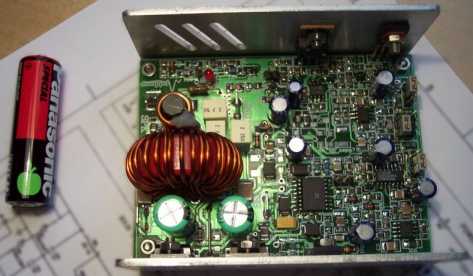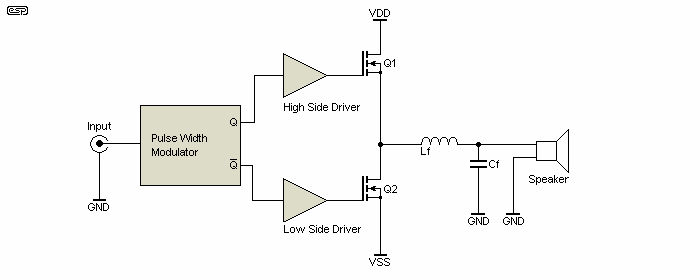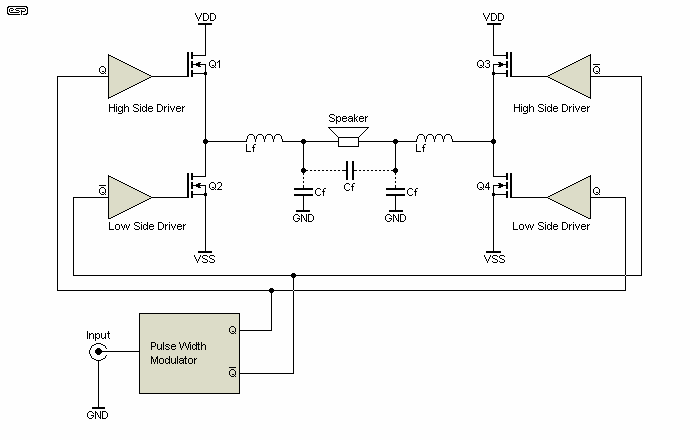what is a class d amplifier used for
Onboard circuitry creates very high-frequency often over 100K Hz pulses of DC current. Class-D amplifiers theoretically can reach 100 efficiency as there is no period during a cycle were the voltage and current waveforms overlap as current is drawn only through the transistor that is on.

Schematic Diagram Of A Class D Amplifier Download Scientific Diagram
Clearly advanced technology can be applied to ameliorate these problems but because of them Class-D amplification is used mainly in applications where efficiency weight and small size are important.

. Efficiency and as a good consequence. This is called pulse width modulation or PWM. Because the transistors of a Class D amplifier are simply used as switches to steer current through the load minimal power is lost due to the output stage.
Also known as a switching power amplifier a Class-D amplifier uses active transistors to function as electronic switches that can be either on or off. A traditional class D amplifier is a switching amplifier usually consisting of two power MOSFETs with pulse-width-modulation PWM signal. Free 2-Day Shipping wAmazon Prime.
The amplifier implements a technique such as pulse-width modulation delta-sigma modulation or pulse-density modulation to convert the input signal into a stream of pulses wherein the time average power of the pulses is proportional to. On the whole Class D Amplifiers not only deliver high-quality sound but are also very energy efficient. Ad Read Customer Reviews.
An LC filter is needed for output levels 20 W which increases both size and costs. Ad Since 1974 Weve Been Helping Customers Choose Use and Enjoy Audio Video and More. They operate by rapidly switching back and forth between the supply rails being fed by a modulator using pulse width pulse density or related techniques to.
Class D amps are called switching amps because theyre either completely on or off. In this Class D amplifier system the linear gain is not accepted as they work just like a typical switch which have only two operations ON or OFF. In the past Class D Amplifiers produced a hard flat sound.
The clarity of the sound is slightly less crisp than the larger amplifiers but not enough for a lay person to discern a large difference. A class-D amplifier or switching amplifier is an electronic amplifierin which the amplifying devices transistors usually MOSFETs operate as electronic switches and not as linear gain devices as in other amplifiers. Thats why Class D is the primary choice for subwoofer amps.
Class D Amplifier. Amplifiers with a digitally generated control that switches a power stage. Class D amplifiers.
Digitally controlled class D. Class D amplifiers operate in a unique fashion. The voltage doesnt change but the period for which it is on does.
Analog-controlled class D. 12 rows Class D Amplifiers have long been termed un-musical and as a result ignored for years. Were Here to Help.
The conduction angle is not a factor in such case as the direct input signal is changed with a variable pulse width. The resulting signal is an amplified version of the input. No error control is present.
Class D amplifier is a switching amplifier which uses Pulse Width Modulation or PWM. Switching amplifiers with an analog input signal and an analog control system. The width of each pulse is then modified by the input signal the wider the pulse the louder the signal.
Any power losses associated with a Class D amplifier are primarily attributed to output transistor on-resistances switching losses and quiescent current overhead. MERUS class D audio amplifier ICs multi-chip modules and discrete MOSFETHEMT driver ICs. A class-D amplifier or switching amplifier is an electronic amplifier in which the amplifying devices transistors usually MOSFETs operate as electronic switches and not as linear gain devices as in other amplifiers.
Class D Amplifier A Class D audio amplifier is basically a non-linear switching amplifier or PWM amplifier. Class D amps are therefore most popular when the frequencies amplified fall far below the switching frequency. A class D amp delivers either all of the current available from its power supply or none.
6 rows Ultimately the complexity of Class D has its rewards. Chat Email or Give Us a Call but Please Excuse our Virginia Accent. Normally some degree of feedback error correction is present.
The output is switched at a very high frequency modulated to the music. To do that a high damping factor is desirable and as mentioned above a simple Class-D amplifier has a low damping factor. Class D amplifiers generally use a low-pass filter to attenuate the switching noise in the output waveform while passing the audio signal to the loudspeaker but many engineers are not familiar with the functions performed by the various components in a Class-D amplifier filter or how to calculate the proper values.
Ad Free 2-day Shipping On Millions of Items. Up to 17 cash back Class D amplifiers popular kings of efficiency.

Class A B D G H To T Audio Amplifiers

Comparator Circuit Class D Amplifier Electronic Circuit
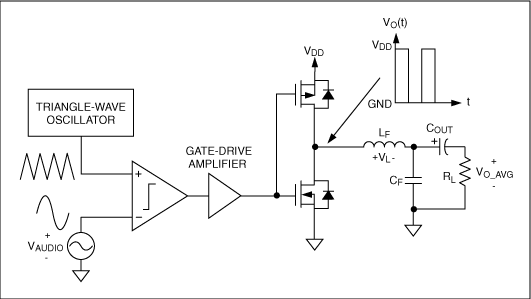
Fundamentals Of Class D Amplifiers Maxim Integrated
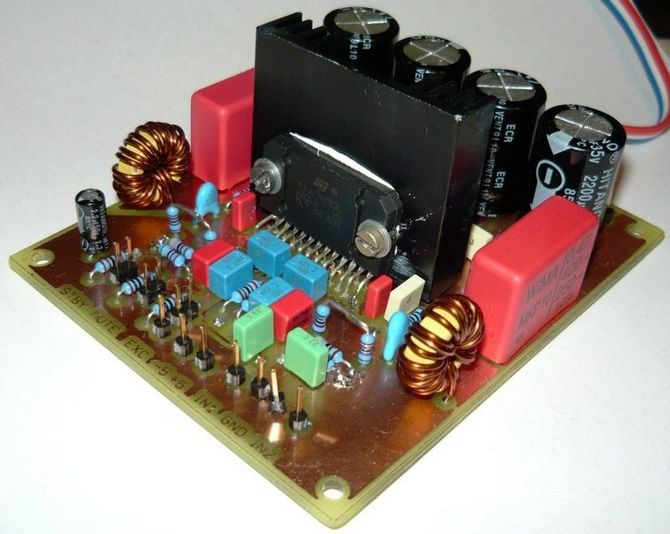
Tda7490 Class D Amplifier Project Electronics Projects Circuits

Simple Diy Class D Amp Rebix Electronicsrebix Electronics
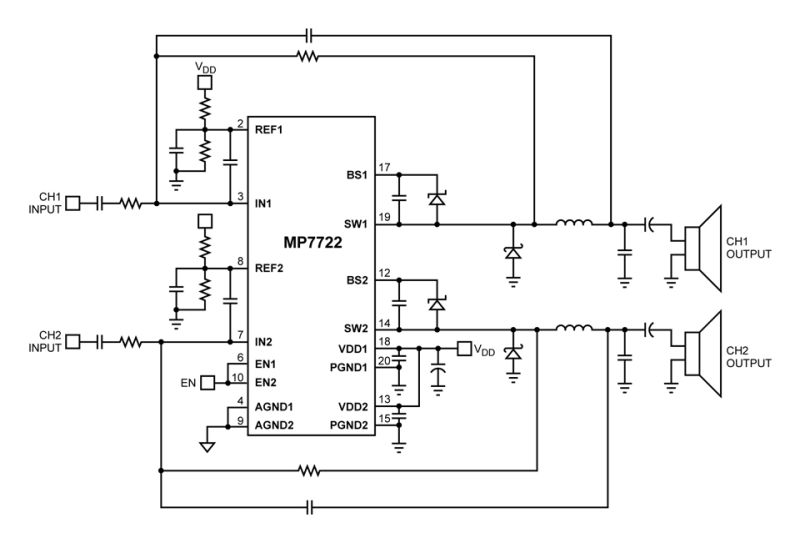
Mp7722 2x20w Class D Stereo Single Ended Audio Amplifier Mps
Diagram Of Class D Audio Power Amplifier Download Scientific Diagram

Class D Power Amplifier Power Electronics News

Which Amplifier Class Is The Best How Class D Amplifier Technology Differs From Class A And Ab

Unfiltered Square Wave As Feedback In Class D Amplifier Electrical Engineering Stack Exchange

Fundamentals Of Class D Amplifiers Maxim Integrated

How To Build A High Efficiency Class D Audio Amplifier Using Mosfets In 2022 Audio Amplifier Audio Amplifier
